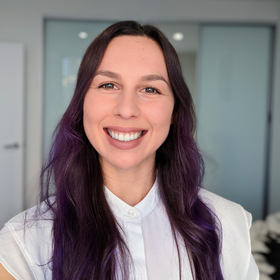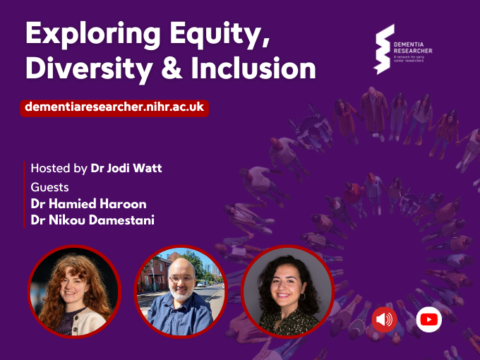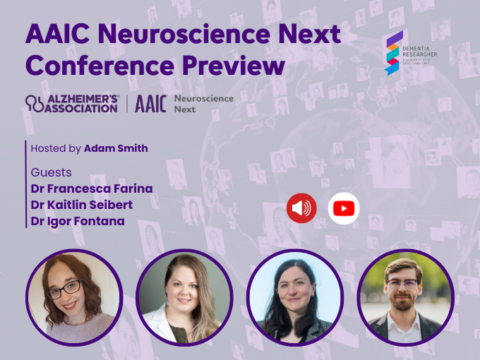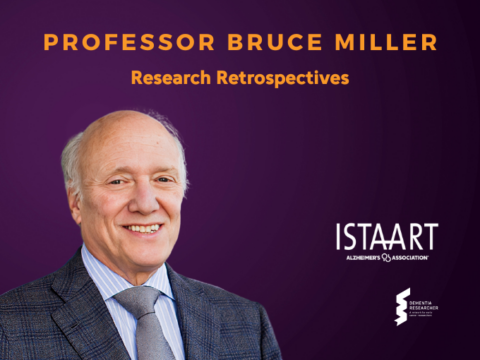This blog is being shared on behalf of the ISTAART Partnering with Research Participants PIA. Research for dementia therapeutics and care occurs in a world that is constantly changing. We can improve accessibility and meaningfulness of research by integrating perspectives of participants in the design and conduct of research, as well as in the way results are disseminated. The Partnering with Research Participants PIA provides a global forum for researchers to share best practices on how to partner with participants, as well as opportunities to learn directly from the lived experiences of a diverse group of research participants.
Las personas de orígenes culturalmente diversos, particularmente aquellas que no hablan inglés, tienden a ser excluidas de las investigaciones sobre la demencia. Este es un tema urgente considerando las disparidades asociadas con el acceso de estas poblaciones a información sobre la demencia, apoyo diagnóstico, intervención, y servicios de atención en lugares altamente multiculturales como Australia, el Reino Unido y los Estados Unidos. Al ver estas diferencias de equidad en nuestras comunidades, inspiró a nuestro equipo a hacer la investigación en demencia accesible, inclusiva y equitativa. Ahora estamos compartiendo las lecciones que hemos aprendido para que otros equipos puedan adoptar la diversidad y evitar los problemas con los que nosotros nos enfrentamos.
Aprovechando de la diversidad en nuestro equipo
Comenzamos a promover la inclusión dentro de nuestro propio equipo de investigación, compuesto por personas de origen macedonio, español y árabe. Esta experiencia se extendió a nuestro trabajo con comunidades multiculturales. Desempacamos las experiencias de aculturación, tradiciones, estilos de comunicación y ética de trabajo de los demás para apreciar cómo podríamos colaborar de manera efectiva. Por ejemplo, durante el Ramadán – un mes santo de ayuno, introspección y oración para los miembros de nuestro equipo musulmán – cambiamos nuestro período de productividad a las horas de la mañana para mitigar la fatiga de la tarde sentido durante el ayuno. Esto también significó reducir nuestros esfuerzos de investigación con las comunidades que estaban honrando el Ramadán (más sobre esto más adelante). En otros ejemplos, aprovechamos el bilingüismo para facilitar el reclutamiento, las reuniones, las sesiones de educación sobre demencia para las comunidades y la traducción de comunicaciones (como este blog, que hemos puesto a disposición en inglés y español). Nos apoyamos en estas prácticas de entendernos mutuamente, colaborando de manera flexible y accesible, para involucrar a las personas que no hablan inglés en la investigación de demencia.
Por qué y cómo adoptar la diversidad en la investigación de demencia – Una perspectiva australiana
Aproximadamente el 45% de los australianos son culturalmente y lingüísticamente diversos y el 21% de la población habla un idioma distinto del inglés en su casa1. Los idiomas más comunes son: árabe, cantonés, mandarín y vietnamita2. A pesar de esto, la investigación sobre demencia suele descuidar las necesidades y perspectivas de estos individuos. Por lo tanto, hemos centrado nuestros esfuerzos en una de las partes más multiculturales de Australia: el suroeste de Sídney, donde las personas que no hablan inglés representan el 54% de la población (sí, la mayoría). La gran presencia de estas comunidades puso en relieve la necesidad de realizar investigaciones sobre demencia de una manera culturalmente sensible y accesible, teniendo en cuenta las barreras del conocimiento de salud. Lo siguiente es como logramos desarrollar la capacidad para la investigación de la demencia culturalmente inclusiva.
La comunidad árabe
Involucrándonos con la comunidad árabe, un primer paso esencial fue averiguar cómo hablar sobre la demencia. El término médico occidental para demencia no se traduce bien en árabe. La terminología árabe para demencia, “kharaf”, se traduce en “deshilachado” o “pérdida de la mente”, que tiene connotaciones negativas circundante a la enfermedad mental. La líder del equipo de investigación, Dra. Diana Karamacoska, dedicó tiempo a establecer relaciones con grupos árabes de personas mayores, asistir a sus reuniones, realizar presentaciones a tamaño reducido y asegurarse de que los miembros bilingües estuvieran presentes para facilitar una comunicación clara utilizando un lenguaje conciso y sencillo. También compartieron que la “enfermedad de Alzheimer” se estaba volviendo más aceptada en sus países de origen, ya que describe una enfermedad física del cerebro. Incorporamos este detalle a nuestro programa de educación sobre demencia; asignándolo como una ‘sesión de información sobre la memoria’ en la que se debatió la enfermedad de Alzheimer como una causa de pérdida de memoria (entre otros síntomas) y se reconoció brevemente el estigma asociado con la demencia y el ‘kharaf’. Otras consideraciones incluyeron ser consciente de las obligaciones culturales y religiosas en las que los miembros de la comunidad árabe pueden participar y que pueden afectar la forma en que se involucran con la investigación. Por ejemplo, el reclutamiento durante Ramadán no será ideal, ya que se considera un mes santo, donde los individuos priorizan la esencia del islam sobre todo lo demás. La participación también puede llegar a ser abrumadora, tanto física como mentalmente, debido al ayuno.
La comunidad vietnamita
La participación e integración con la comunidad vietnamita era importante para asegurar que las personas fueran receptivas a la educación y la investigación sobre demencia. Nuestro equipo empleó a un investigador de habla vietnamita para involucrarnos en eventos locales celebrando la cultura vietnamita y para ayudarnos a conectarnos con asociaciones y proveedores de servicios. La comunidad apreció cuando la investigadora principal, la Dra. Diana Karamacoska, asistió a eventos porque valoraron la iniciativa que tomó un experto académico para conectarse con ellos. Sin embargo, cuando se trataba de participar en las encuestas, problemas relativos a la duración y los niveles de alfabetización se convirtieron en barreras para los vietnamitas mayores. Como resultado, hemos tenido que repensar nuestros protocolos y ahora hemos incluido una opción para las formas de comunicación verbal/oral en el proceso de investigación (como la obtención de consentimiento informado y la realización de encuestas).
La comunidad China
Nuestra capacidad para trabajar con las comunidades de habla cantonesa y mandarín se desarrolló a través de asociaciones con dos proveedores de servicios de cuidado de ancianos apasionados por el tema de la demencia y su promoción. Los proveedores de servicios ofrecieron voluntarios bilingües para participar en nuestros esfuerzos de investigación de co-creación: Desde el diseño de un programa de educación sobre demencia, la traducción de los recursos, la facilitación de sesiones en el idioma con la experta académica (Dra. Diana Karamacoska), la evaluación del impacto, hasta la difusión con una conferencia de presentación y un informe en lenguaje sencillo. También nos informaron de las campañas de concientización sobre demencia en China – donde se estaban introduciendo nuevos términos para la demencia, como la enfermedad degenerativa y el deterioro neurocognitivo, para sustituir el término original tan estigmatizado. Incorporamos estos nuevos términos en nuestro material para que las personas pudieran compartir la información con sus seres queridos en China.
Conclusión
En resumen, al trabajar con comunidades diversas, es importante ser de mente abierta y flexible en su enfoque. Si estás sintiendo resistencia, es una señal de que debes considerar cómo su acercamiento está siendo recibido por el grupo con que deseas trabajar. Hablar con las poblaciones con las que desea participar mientras valorando sus aportaciones y complejidades, generará resultados y le ayudará a conectarse más allá de un nivel de investigación académico. Seguir el libro de reglas académicas de reclutamiento y compromiso de participantes no funcionó. Así que, atrévase con estas culturas, aproveche las estructuras o servicios existentes donde sea posible, y construya relaciones significativas que beneficien a su gente (y, por extensión, a su investigación).
Gracias a nuestro maravilloso equipo por armar este proyecto: Dra. Diana Karamacoska, Gabriela Caballero, Eman Shatnawi, Yousra Ali, Flor Sanabria Vasquez y Jeannette Woodward.
Referencias bibliográficas
- Australian Institute of Health and Welfare (2018). Australia’s health 2018. Australia’s health series no. 16. AUS 221. Canberra: AIHW.
- Australian Bureau of Statistics. 2016 Census. Canberra, ACT: ABS; 2016. Available from: https://quickstats.censusdata.abs.gov.au/census_services/getproduct/census/2016/quickstat/LGA11570?opendocument.
People from culturally diverse backgrounds, particularly those that do not speak English, tend to be excluded from dementia research. This is a pressing issue considering the disparities associated with these populations accessing information about dementia, diagnostic support, interventions, and care services in highly multicultural places like Australia, UK, and USA. Seeing the impacts of these gaps in our own communities inspired our team to make dementia research accessible, inclusive, and equitable. We’re now sharing the lessons that we’ve learnt so that other teams can intentionally embrace diversity (and avoid the hiccups we encountered).
Embracing diversity in our own team
We started promoting inclusivity within our own research team, comprising people from Macedonian, Spanish, and Arabic speaking backgrounds. This experience rippled into our work with multicultural communities. We unpacked each other’s acculturation experiences, traditions, communication styles, and work ethic to appreciate effective collaboration. For example, during Ramadan – a holy month of fasting, introspection, and prayer for our Muslim team members – we shifted our productivity period to the morning hours to address the afternoon fatigue felt during fasting. This also meant scaling back our research efforts with the communities that were honouring Ramadan (more on this later). In other examples, we leveraged bilingualism to facilitate recruitment, meetings, dementia education sessions for communities, and translating communications (such as this blog post, which we made available Spanish as well)! We leaned on these practices of understanding each other, collaborating in flexible, accessible ways, to engage non-English speaking people in dementia research.
Why and how to embrace diversity in dementia research – An Aussie Perspective
Approximately 45% of Australians are culturally and linguistically diverse (Australian Institute of Health and Welfare, 2018) with 21% of the population speaking a language other than English at home. The most common languages are: Arabic, Cantonese, Mandarin, and Vietnamese (ABS, 2016). Despite this, dementia research often neglects the needs and perspectives of these individuals. We have thus been focusing our efforts on one of the most multicultural parts of Australia: South Western Sydney, where non-English speaking people represent 54% of the population (yep, the majority). The large presence of these communities highlighted the need to conduct dementia research in a culturally sensitive and accessible way; taking into account health literacy barriers. Here’s how we managed to build capacity for culturally inclusive dementia research.
Arabic Community
When engaging with the Arabic community, an essential first step was addressing how to talk about dementia. The Western medical notion of dementia does not translate well in Arabic. The Arabic terminology for dementia, “kharaf”, translates to “unravelled” or “loss of mind”, which has negative connotations surrounding mental illness. The research team leader, Dr Diana Karamacoska, spent time building relationships with Arabic seniors’ groups, attending their gatherings, delivering bite-sized presentations, and ensuring that bilingual members were present to facilitate clear communication using simple, concise, and plain language. They also shared that the term “Alzheimer’s disease” was becoming more accepted in their home countries as it describes a physical brain illness. We took this on board for our dementia education program; badging it as a ‘memory information session’ that discussed Alzheimer’s disease as a cause of memory loss (among other symptoms) and briefly acknowledged the stigma associated with dementia and ‘kharaf’. Other considerations included being aware of cultural and religious obligations that members of the Arabic community may take part in that can affect how they engage with research. For example, recruiting during Ramadan may not be ideal, as it is considered a holy month, where individuals prioritise worship over everything else. Participation may also become overwhelming, both physically and mentally, because of fasting.
Vietnamese Community
Participation and integration with the Vietnamese community was important in ensuring people were receptive to dementia education and research. Our team employed a Vietnamese-speaking researcher to get us involved in local events celebrating Vietnamese culture and to help connect us with associations and service providers. The community appreciated it when the lead researcher, Dr Diana Karamacoska, attended events as they value the initiative an academic expert has taken to engage with them. When it came to participating in surveys, however, length and literacy levels became a barrier for both elderly Vietnamese people. We’ve had to rethink our protocols as a result and have now included an option for verbal/oral forms of communication in the research process (such as obtaining informed consent and conducting surveys).
Chinese Community
Our capacity to work with the Cantonese and Mandarin speaking communities was built through partnerships with two aged care service providers who are passionate about dementia and advocacy. The service providers volunteered bilingual workers to be involved in our co-creation research efforts: from designing a dementia education program, translating the resources, facilitating in-language sessions with the academic expert (Dr Diana Karamacoska), evaluating impact, through to dissemination with a conference presentation and plain-language report. They also informed us of the dementia awareness campaigns that they heard about in China – where new terms for dementia, such as degenerative disease and neurocognitive impairment, were being introduced to replace the original term that was so highly stigmatised. We incorporated these new terms into our material so that people could share the information with their loved ones in China.
Conclusion
In summary, when working with diverse communities, it is important to be open minded and flexible in your approach. If you are feeling resistance, it is a sign that you should consider how your approach is being received by the group you want to work with. Speaking to the populations you wish to engage with, valuing their input and intricacies, will wield results and help you connect beyond a research level. Following the academic rule book of participant recruitment and engagement did not work. So, engross yourselves in these cultures, leverage existing structures or services where possible, and build meaningful relationships that will benefit their people (and, by extension, your research).
Thank you for our wonderful team for putting this together: Dr Diana Karamacoska, Gabriela Caballero, Eman Shatnawi, Yousra Ali, Flor Sanabria Vasquez, and Jeannette Woodward.

Dr Diana Karamacoska
Authors
Dr Diana Karamacoska is a Postdoctoral Research Fellow at Western Sydney University with a background in cognitive neuroscientist. Diana is moving in to the the public health field after seeing the stigma, health disparities, and lack of appropriate education about dementia in multicultural communities. Diana is also Vice Chair of the ISTAART Partnering with Research Participants PIA.

Gabriela Caballero
Gabriela Caballero (who provided the Spanish translation and narration for this blog) is a Researcher and PhD candidate in the NICM Health Research Institute, Western Sydney University. She recently completed a Bachelor of Psychology, during this time she worked as a crisis supporter and as a research assistant on multiple dementia-related projects. Gabriela’s PhD focuses on improving the quality of life for multicultural communities impacted by dementia.

 Print This Post
Print This Post




